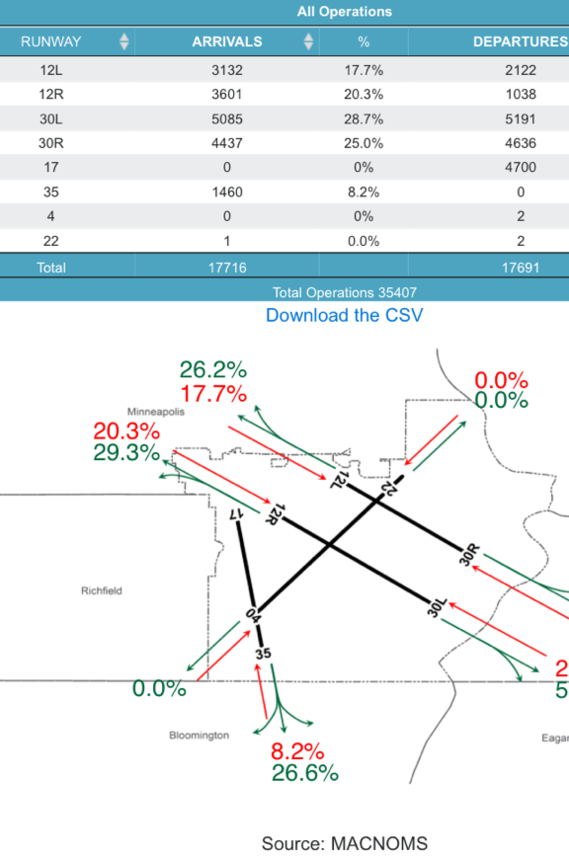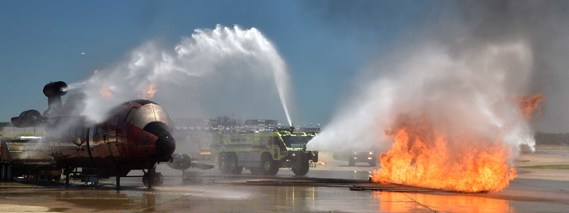|
The Metropolitan Airports Commission (MAC) has long published detailed reports for neighbors concerned about aircraft noise around Minneapolis-St. Paul International Airport.
Recently, the MAC launched a new web-based interactive reporting tool that makes finding the data you’re looking for fast and easy.
“Until now, data was spread across five static reports issued monthly and totaling more than 85 pages. There was no simple way for people to filter the data to meet their specific needs,” said Brad Juffer, assistant manager for Noise, Environment and Planning at the MAC.
 One of the data displays available on the Noise Reports website.
“The new online reporting tool enables users to sort and display the data in a variety of ways and provides graphics to make the information easier to understand. There are overview pages for people who just want a summary, and more detailed information is available for those who want to dive deeper into the data. We tried to make the new tool as intuitive and well organized as possible.”
Interactive reports are provided in four categories: Operations, Complaints, Sound Monitoring and Abatement. Each section includes maps and visual aids to help viewers understand the data.
The tools were developed for desktop browsers and mobile devices. In many cases, both recent and historical data are available so users can see changes over time.
Juffer said the first-of-its kind interactive airport data system also offers information that wasn’t available in the static reports.
The “Runway Use System” reporting tool demonstrates how winds can affect runway use. Also, flights to and from MSP International are summarized monthly into a map that displays flight counts for each geographic segment of the seven-county metropolitan area.
Users can apply specific runway and operations filters to display the average altitude of the aircraft in each geographic segment as well.
In the short time it's been online, the interactive website has seen visitors from 11 different countries and 32 states.
“The Metropolitan Airports Commission strives to be transparent and responsive to community needs,” said MAC CEO Brian Ryks. “Through communication advances like this new reporting tool, quarterly public listening sessions and a new online video series, we’re providing information in ways we hope will help our neighbors understand how aircraft are using the airport and the nearby airspace.”
The new web-based reporting tool is available at this location.
Seventeen lucky regional aviation students spent a recent week learning from the pros at Minneapolis-St. Paul International Airport (MSP) through Airside Operations' annual “Boot Camp” program.
Part 139 Boot Camp – a five-day, hands-on course for aviation majors – gives students from around the region a snapshot of what it takes to run a large hub airport. Participants attend real airport training courses taught by MAC staff and other experts, all the while getting a glimpse of what happens behind the scenes at MSP.
“This year’s group was about a 60/40 mix of airport management students and pilots,” said John Ostrom, manager of Airside Operations and camp organizer. “With 17 students, we had a great turn out.”
 During the five-day camp, the group took a total of 14 classes, including wild life management, night inspections, winter operations, driver’s training, aircraft firefighting and rescue, and pavement maintenance. And of course, all students were able to participate in an airfield tour.
Airside has hosted the boot camp for the past seven years, and although many courses and elements are carried over year after year, no two years are exactly the same.
“We review feedback each year, and try to meet the students’ expectations,” Ostrom said. “We’re always tweaking and refreshing.”
While most of the courses are taught by Airside Operations staff, other departments pitch in as well. Charlie Beuning, assistant manager of Field Maintenance, taught the group about pavement maintenance and winter operations; and Greg Fuller, assistant fire chief, also dropped in during the week to teach the students about aircraft firefighting and rescue.
The camp is well-known throughout the region, and local colleges with aviation programs often hand pick students to participate. This year, students from Minnesota State University, Mankato; the University of North Dakota; and Metro State University participated in the program.
For the students, the best part of the week is the hands-on experience. For Ostrom, the best part is seeing boot camp alumni working in the industry.
“It’s an opportunity to train the next generation,” Ostrom said. “It gives you a sense of satisfaction.”
In fact, Airside Operation’s current graduate intern, Kristina Conklin, is a 2013 boot camp alumna.
“Kristina stepped up and taught one of the courses this year and she did a great job,” Ostrom said.
The unique experience of being on both sides of boot camp was not lost on Kristina.
“It was pretty cool to be able to come full circle this year,” she said.
The Airport Fire Department recently conducted its annual "live fire" training at Minneapolis-St. Paul International Airport (MSP). This training is mandated by the Federal Aviation Administration (FAA) and allows firefighters to safely practice firefighting and rescue tactics for a variety of scenarios.
“This year, we used a mobile aircraft trainer from Kellogg Community College in Battle Creek, Michigan,” said Greg Fuller, assistant fire chief/training officer. “It can simulate both fuel spills and fuselage fires using propane.”
With the assistance of the mobile trainer, firefighters are able to safely practice using hand lines and full protective gear to put out fires at close range, as well as work together in the trucks to tag-team fires in multiple locations.
“There’s a ‘kill switch’ for the trainer that puts out the flames immediately,” Fuller said. “So if something goes wrong, we can keep everyone safe.”
 MSP’s fire trucks have some unique features that aren't found on standard equipment.
Firefighters have the ability to drive and pump at the same time, and use a special tool for puncturing aircraft so water can be pumped in. The trucks hold up to 3,000 gallons of water. Training sessions give the department a chance to practice using these tools on live flames.
The FAA requires the fire department to perform these training sessions every 12 consecutive months for MSP to remain compliant with its commercial airport certification.
When performing trainings at MSP, the fire department works to minimize the impact to operations. Propane flames produce minimal smoke, making the training less visible. Additionally, the department uses water to control the test flames instead of foam, which lessens the environmental impact.
Everyone in the department is required to participate in the training regardless of experience level, from the chief down to new recruits. This year, other fire departments that serve a few of the reliever airports were also provided special aircraft firefighting training using the mobile trainer at MSP.
Board Meetings
Business Opportunities
Career Opportunities
General Aviation Airport Information
MSP Aircraft Noise Information
MSP Airport
|